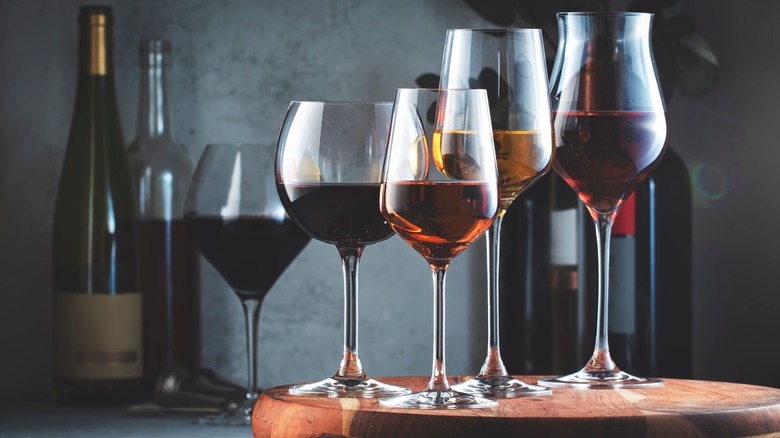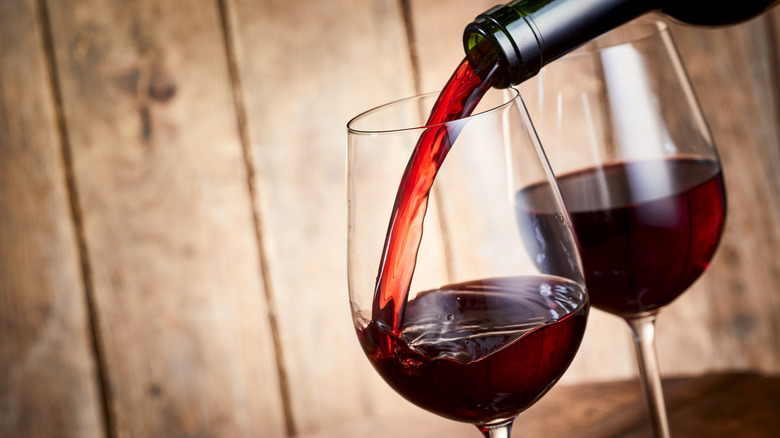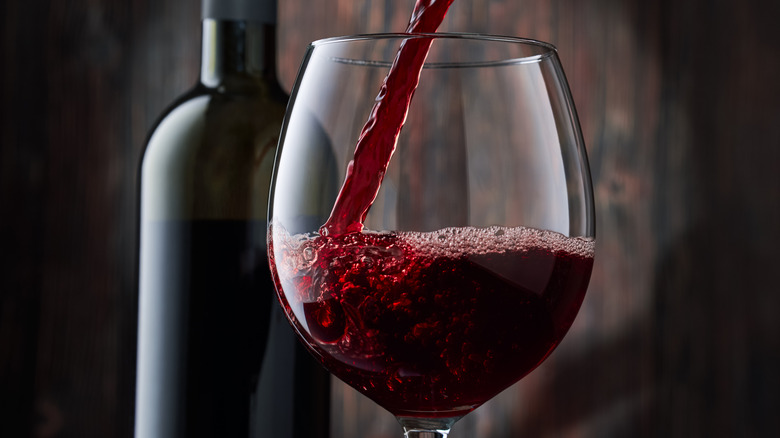The Difference Between Burgundy And Bordeaux Wine Glasses
While it's a judgment-free zone for how you choose to consume your wine — everything from mason jars to mugs will suffice — when you're ready to build out your bar cart, you may be wondering which types of glasses you need to invest in. Do you need all the shapes and sizes? Sets for red and white? To stem or not to stem? A set of flutes for that annual New Year's Eve toast?
The differences in wine glasses go far beyond red vs. white. While there are several variations and shapes that fall into each color category, the two common red glasses you come across cover two winemaking regions of France, Burgundy and Bordeaux. Much like how the wine bottles of these two areas are shaped differently, so are the glasses they're best enjoyed in.
Bordeaux and Burgundy are regions with very different styles of wine due to the variety of grapes planted and the climate. Burgundy is further north and cooler whereas Bordeaux is toward the south and warmer. When speaking of these two regions, most are referring to red wines. However, there are dry white wines that are produced in both. So, what are the main differences between a Burgundy and Bordeaux wine glass?
Bordeaux wines are big and so are the glasses
When you imagine a typical red wine glass, this is probably what you are envisioning. It's the tallest of the red wine glasses with a large, wide bowl and long stem. These glasses are built for volume and taper off toward the top.
The height of the glass is designed so the wine will hit the back of your mouth and maximize its flavor. The height also creates a large chimney in the glass. The chimney is the space between the surface of the wine pour and the rim of the glass. A larger one allows for more oxygen exposure which softens tannins and helps develop the aromas.
Some of the most popular wines come from the Bordeaux region and are best enjoyed in these glasses. They are full-bodied, red wines mostly composed of cabernet and merlot grapes. The grapes in this region are darker in color and thicker skinned, lending to more tannins, flavor, and a darker-colored wine.
You'll want to reach for one of these glasses to enjoy cabernet sauvignon, merlot, and other rich, strong wines such as syrah, malbec, petite sirah, cabernet franc, and Bordeaux blends.
A more delicate glass for a more delicate wine
Compared to the Bordeaux glass, the Burgundy glass is shorter and much more bulbous. It has a wider brim which allows for more aeration as well as for the aromas to concentrate and showcase the fruit of the wine. The top is more narrow than the Bordeaux glass. The Burgundy glass is designed with a shorter, bigger bowl to make the tongue's tip touch the wine and pick up on the more delicate flavor nuances.
Wines from the much smaller Burgundy region of France are fruitier and delicate. Some of the most expensive varieties in the world come from this region. The most prevalent red grapes from this region are thin-skinned and lighter in tannins and flavonoids, which results in lighter-colored wine. The two main grapes from this region are pinot noir and chardonnay. There are other red varieties, such as Beaujolais from the Gamay sub-region, but if it's red and from Burgundy, it's most likely a pinot noir.
The best wines to pour into a Burgundy glass include lighter varieties such as pinot noir, Beaujolais, barbaresco, baralo, barbera, and dolcetto.
So can you swap between the two glasses with minimal issue? Given the design nuances that affect the aeration and where the wine hits your palate, you probably don't want to. But either one is definitely better than a mason jar or Solo cup.


